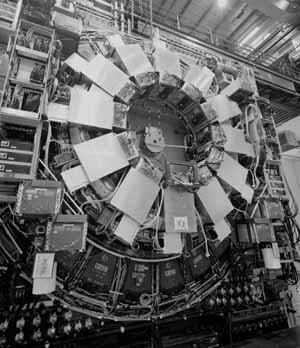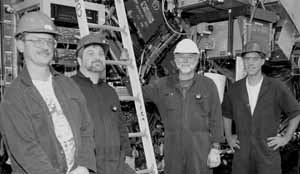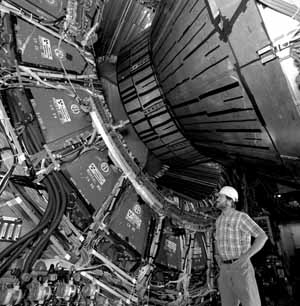 |
|
CDF On a Roll by Kurt Riesselmann
The roll-in marks a new stage in preparations for Collider Run II of the Tevatron. When Run II officially begins in March 2001, the 500-member CDF collaboration, along with an equal number of colleagues across the Tevatron at the DZero detector, will take up the search for new physics at the energy frontier: the Higgs boson, supersymmetry, extra dimensions and other exotic phenomena. A team of technicians nicknamed "The blue-men group" finished the three-day job of transferring the massive detector inch by inch from its assembly hall to the collision hall, right in the middle of the beamline of the Tevatron, the world's highest-energy particle accelerator. "Harry Carter and his colleagues only needed two days for moving our huge detector to the collision hall, a distance of 200 feet," said Fermilab physicist Pat Lukens, member of the CDF collaboration. "That happened much faster than we had anticipated." "On the third day, guided by Fermilab's Alignment Group, they nudged the detector into its correct position, with the precision of half a millimeter."
Physicists around the world watched the roll-in as a web cam posted pictures on the CDF website. Moving the 30-foot wide and 35-foot long detector literally is a big task. The detector, which usually rests on the floor, can be lifted with eight hydraulic cylinders, each sitting on top of a set of steel-wheeled rollers. Once the detector is "air-borne," a second hydraulic system pushes the detector forward. If the wheels and the whole detector start to move in the wrong direction, the technicians lower the detector to the floor, re-align the wheels, re-lift the detector and try again.
"The roll-in is a small but highly visible step of the whole installation process for Run II," explained Lukens. He and fellow physicist Rob Roser are in charge of CDF's Installation and Infrastructure group. They must orchestrate the complex integration of many different subsystems, built by scientists around the world, into one precisely functioning detector.
The CDF collaboration is completing what Lukens calls a "fast, partial installation" to get the detector ready for a six-week test run. It provides the first opportunity to test all detector components simultaneously, using a low number of collisions provided by a Tevatron test beam. "Every group of scientists, of course, makes sure that their detector subsystem works," said UC Berkeley physicist Young-Kee Kim UC Berkeley physicist Young-Kee Ki. "But when you put it all together, you have to make sure that there is no interference among the various electronic subsystems and that you synchronize the data they record." Physicists need to eliminate the possibility that signals from two subsequent collisions, happening less than one millionth of a second apart, get mixed up. Kim is supervising the commissioning of the detector and its components. Her job is making all equipment function simultaneously. "We have a meeting every day at 8:00 a.m. to talk about problems with the subsystems and to take steps to resolve them," Kim said. "It helped a lot that we could take data with large parts of the detector assembled using cosmic rays just a few weeks ago."
The countdown for the full installation of the CDF detector will begin in November. At that time, the test run will be complete, and the detector will roll back out to the assembly hall. Then, both the CDF collaboration and its neighbor down the beamline, DZero, have four months for gearing up their detectors for the final installation. For the CDF detector, this includesóamong other thingsóthe installation of the complete silicon central tracker, a very sensitive device that can precisely record particle tracks near the collision point. Presently, only a small part of the silicon tracker is in place, sufficient to test the system. "We are still working on parts of the cooling system for the full silicon tracker," said Rich Stanek, project engineer for the CDF detector. "With the detector in the collision hall, we have the chance to observe unanticipated operational problems and make corrections before Run II begins in March 2001." At the moment, the CDF collaboration is pleased with the progress they have made. "It is beginning to look like a detector," Lukens said. He and Roser need to organize the teams that will operate and maintain the CDF detector during Run II. Physicists will work in round-the-clock shifts to supervise the experiment and its supporting equipment. Kim is aware that right now--with the roll-in complete--she may actually have the biggest job to be done. Proper functioning electronics is elementary to recording particle collisions. The success of the cosmic ray test was a first step that made her--and the whole CDF collaboration--very happy. Anticipation and excitement are rapidly increasing. "We can do it," Kim said. |
| last modified 10/6/2000 email Fermilab |
FRLsDFx9eyfrPXgV
 In a major milestone for particle physics, the Collider Detector at Fermilab collaboration rolled the heart of its 5,500-ton detector into the Tevatron beamline on September 9 to begin a "commissioning run" for testing the thoroughly revamped apparatus.
In a major milestone for particle physics, the Collider Detector at Fermilab collaboration rolled the heart of its 5,500-ton detector into the Tevatron beamline on September 9 to begin a "commissioning run" for testing the thoroughly revamped apparatus.
 Completion of this roll-in is the latest achievement in a series of steps that started after the CDF experiment recorded the last collisions of Tevatron Run I in February 1996. During Run II, set to begin in March 2001, the detector must handle a 20-fold increase in number of collisions compared to Run I. Each second, three million proton-antiproton collisions at a new record-high energy of almost 2 TeV, a ten percent increase, will leave their tracks inside the detector.
Completion of this roll-in is the latest achievement in a series of steps that started after the CDF experiment recorded the last collisions of Tevatron Run I in February 1996. During Run II, set to begin in March 2001, the detector must handle a 20-fold increase in number of collisions compared to Run I. Each second, three million proton-antiproton collisions at a new record-high energy of almost 2 TeV, a ten percent increase, will leave their tracks inside the detector.
 Before starting the roll-in, their team spent about two and a half weeks preparing the move by connecting cables of subsystems and installing end caps, the giant plug-shaped components that measure the energy of particles leaving the detector in the forward and backward directions. The end caps also serve as part of the iron yoke that carries a strong magnetic field, created by a superconducting solenoid inside the detector.
Before starting the roll-in, their team spent about two and a half weeks preparing the move by connecting cables of subsystems and installing end caps, the giant plug-shaped components that measure the energy of particles leaving the detector in the forward and backward directions. The end caps also serve as part of the iron yoke that carries a strong magnetic field, created by a superconducting solenoid inside the detector.
 Kim's presence at Fermilab is so crucial that she took a year leave from her faculty position at the University of California, Berkeley. Since finishing teaching in May, she has been at Fermilab.
Kim's presence at Fermilab is so crucial that she took a year leave from her faculty position at the University of California, Berkeley. Since finishing teaching in May, she has been at Fermilab.